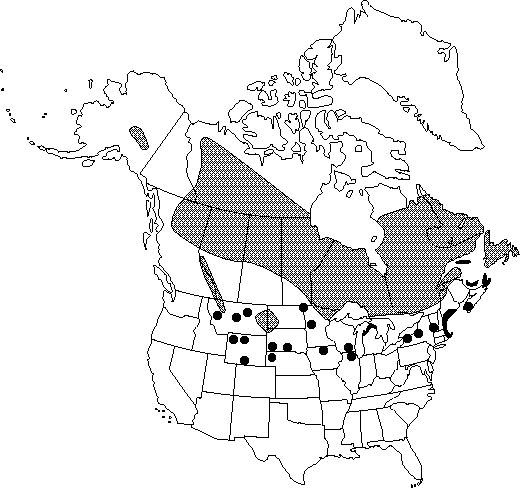Difference between revisions of "Juniperus horizontalis"
Methodus 699. 1794.
imported>Volume Importer |
GeoffLevin (talk | contribs) m (Fixed Nfld. and Labr. distribution to match printed version.) |
||
| (2 intermediate revisions by 2 users not shown) | |||
| Line 34: | Line 34: | ||
|habitat=Sand dunes, sandy and gravelly soils, prairies, slopes, rock outcrops, and stream banks | |habitat=Sand dunes, sandy and gravelly soils, prairies, slopes, rock outcrops, and stream banks | ||
|elevation=0–1000 m | |elevation=0–1000 m | ||
| − | |distribution=St. Pierre and Miquelon;Alta.;B.C.;Man.;N.B.;Nfld. and Labr. | + | |distribution=St. Pierre and Miquelon;Alta.;B.C.;Man.;N.B.;Nfld. and Labr.;N.W.T.;N.S.;Nunavut;Ont.;P.E.I.;Que.;Sask.;Yukon;Alaska;Ill.;Iowa;Maine;Mass.;Mich.;Minn.;Mont.;Nebr.;N.H.;N.Y.;N.Dak.;S.Dak.;Vt.;Wis.;Wyo. |
|discussion=<p><i>Juniperus horizontalis</i>, a prostrate species, hybridizes with the trees <i>J. virginiana</i> and <i>J. scopulorum</i> (R. P. Adams 1983; N. C. Fassett 1945; M. Palma-Otal et al. 1983) and is closely related to both. The hybrid between <i>J. horizontalis</i> and <i>J. scopulorum</i> has been named J. × fassettii Boivin.</p> | |discussion=<p><i>Juniperus horizontalis</i>, a prostrate species, hybridizes with the trees <i>J. virginiana</i> and <i>J. scopulorum</i> (R. P. Adams 1983; N. C. Fassett 1945; M. Palma-Otal et al. 1983) and is closely related to both. The hybrid between <i>J. horizontalis</i> and <i>J. scopulorum</i> has been named J. × fassettii Boivin.</p> | ||
|tables= | |tables= | ||
| Line 52: | Line 52: | ||
|habitat=Sand dunes, sandy and gravelly soils, prairies, slopes, rock outcrops, and stream banks | |habitat=Sand dunes, sandy and gravelly soils, prairies, slopes, rock outcrops, and stream banks | ||
|elevation=0–1000 m | |elevation=0–1000 m | ||
| − | |distribution=St. Pierre and Miquelon;Alta.;B.C.;Man.;N.B.;Nfld. and Labr. | + | |distribution=St. Pierre and Miquelon;Alta.;B.C.;Man.;N.B.;Nfld. and Labr.;N.W.T.;N.S.;Nunavut;Ont.;P.E.I.;Que.;Sask.;Yukon;Alaska;Ill.;Iowa;Maine;Mass.;Mich.;Minn.;Mont.;Nebr.;N.H.;N.Y.;N.Dak.;S.Dak.;Vt.;Wis.;Wyo. |
|reference=None | |reference=None | ||
|publication title=Methodus | |publication title=Methodus | ||
|publication year=1794 | |publication year=1794 | ||
|special status=Endemic | |special status=Endemic | ||
| − | |source xml=https:// | + | |source xml=https://bitbucket.org/aafc-mbb/fna-data-curation/src/2e0870ddd59836b60bcf96646a41e87ea5a5943a/coarse_grained_fna_xml/V2/V2_645.xml |
|genus=Juniperus | |genus=Juniperus | ||
|section=Juniperus sect. Sabina | |section=Juniperus sect. Sabina | ||
Latest revision as of 21:15, 20 February 2024
Shrubs dioecious, prostrate to decumbent; crown depressed. Bark brown, exfoliating in thin strips, that of small branchlets (5–10 mm diam.) smooth, that of larger branchlets exfoliating in wide strips or plates. Branches creeping; branchlets erect, 3–4-sided in cross section, ca. 2/3 or less as wide as length of scalelike leaves. Leaves green but turning reddish purple in winter, abaxial gland elliptic, conspicuous, exudate absent, margins entire (at 20× and 40×); whip leaves 4–8 mm, not glaucous adaxially; scalelike leaves 1.5–2 mm, mostly overlapping to 1/3 their length, apex rounded or obtuse to acute and apiculate, spreading. Seed cones mostly maturing in 2 years, of 2 distinct sizes, generally with curved peduncles, globose to ovoid, 5–7 mm, blue-black to brownish blue when mature, lightly glaucous, soft and resinous, with 1–2(–3) seeds. Seeds 4–5 mm. 2n = 22.
Habitat: Sand dunes, sandy and gravelly soils, prairies, slopes, rock outcrops, and stream banks
Elevation: 0–1000 m
Distribution

St. Pierre and Miquelon, Alta., B.C., Man., N.B., Nfld. and Labr., N.W.T., N.S., Nunavut, Ont., P.E.I., Que., Sask., Yukon, Alaska, Ill., Iowa, Maine, Mass., Mich., Minn., Mont., Nebr., N.H., N.Y., N.Dak., S.Dak., Vt., Wis., Wyo.
Discussion
Juniperus horizontalis, a prostrate species, hybridizes with the trees J. virginiana and J. scopulorum (R. P. Adams 1983; N. C. Fassett 1945; M. Palma-Otal et al. 1983) and is closely related to both. The hybrid between J. horizontalis and J. scopulorum has been named J. × fassettii Boivin.
Selected References
None.